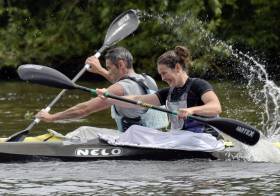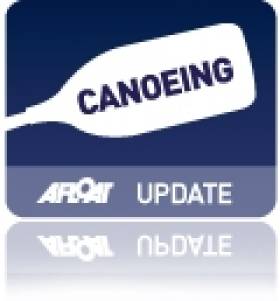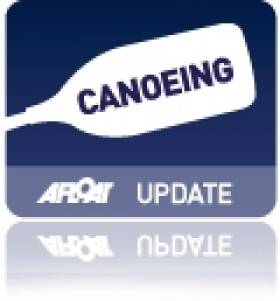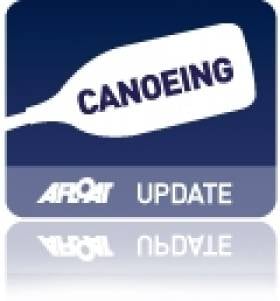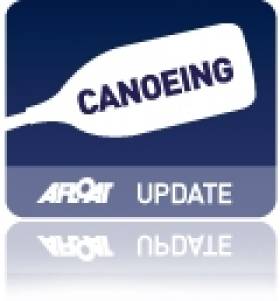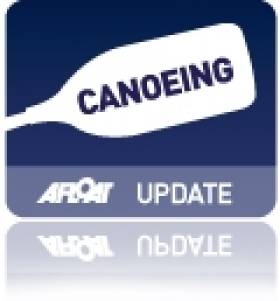Displaying items by tag: Watkins
Jenny Egan and Peter Egan in Same Boat for Liffey Descent
#Canoeing: An international contingent will take on the Liffey Descent this Saturday, September 23rd. A Spanish crew who are determined to beat all comers in the canoe race will contend with a world champion from South Africa in a field of over 500 competitors. The Irish resistance will include a first time pairing in the race of world championship medallist Jenny Egan with her brother Peter – a winner last year.
Top competitors will be fitted with GPS trackers so the public can follow their progress down the course.
The race from Straffan in Kildare to Islandbridge in Dublin is one of the most spectacular events of the Irish sporting calendar. Kayaks and canoes will hurtle down the 30-kilometre stretch. They will find their way over 10 weirs, and paddlers must scramble out and carry their boat down the bank at Leixlip. Spectators can view the speed and the spills from the bridges and the banks. The start is at 12 o’clock.
The line-up for the K2, the racing kayak which is set to be the fastest boat of the day, should make for an exciting race.
Ireland international Barry Watkins teams up with Jon Simmons, who has been coaching developing paddlers in Ireland system. They take on the accomplished Spanish pairing of Luis Amado and Miguel Llorens, who took fourth in the World Marathon Championships in South Africa earlier this month. From South Africa comes Sean Rice, a world champion in surfski racing, who teams up with Briton Tom Sharpe.
Last year Peter Egan was in the front of the K2 which won – this time the paddler behind him will be his sister, Jenny, in a mixed K2. “We’ve always wanted to do it, but the circumstances were never right before,” Jenny said.
The Egans come directly from the World Championships, where Jenny took a bronze medal. But they will be tested on Saturday. From Germany comes Andreas Heilinger and Inez Bauerle; from the Netherlands, Pascal Lucker and Eef Haaze.
Ireland international Tom Brennan will hope to retain his title in the K1 (individual racing kayak). He fell in at Straffan last year and then got back on track to win. Ronan Foley, who was the fifth best junior at the World Championships in South Africa, could test him.
They will be competing for silver trophies, back as rewards in this race after a time when they were not presented.
Fleming's K2 Fastest in Liffey Descent
#CanoeingLiffeyDescent: Neil Fleming and Robin Koenders were the fastest crew home at the 56th Liffey Descent today. In a race run in warm sunshine and light winds from Straffan to Islandbridge, the K2 of Fleming and Dutchman Koenders gained a considerable lead by Lucan over nearest challengers Gary Mawer and Barry Watkins. The winning time of one hour 48 minutes 32 seconds was outside the record for the course.
The fastest K1 paddler was Tom Brennan, winning this class for the first time, and coming home well under two hours.
Jenny Egan and her boyfriend Jon Simmons won the mixed K2. They set a new record time of one hour 53 minutes and 26 seconds.
Liffey Descent 2015 (Selected Results)
K2: 1 R Koenders, N Fleming 1 hour 48 minutes 32 seconds, 2 B Watkins, G Mawer 1:51.00, 3 L Van Riet, E Van Riet (Sth Africa) 1:51.42. Junior: C Crate, J O’Hagan 2:05.04. Master: D Halton, J Morrissey 2:02.51.
K1: 1 T Brennan 1:56.22, 2 J Boyton 1:59.38, 3 M Brennan 1:59.44. Junior: E Forristal 2:05.35.
K2 Mixed: J Simmons, J Egan 1:53.26.
Wildwater - Junior: C Clarke 2:19.16
General Purpose – Junior: 2:35.34. Masters: J Mescal 2:31.30. Veteran: E Moran 2:43.36.
#CANOEING: Pat O’Leary qualified for the final of the KL3 paracanoeing event at the European Sprint Championships in Racice in the Czech Republic today. O’Leary finished second in his heat of the 200 metre event. Barry Watkins and Michael Fitzsimons finished 2.82 seconds behind the winners, Lithuania, in the semi-final of the K2 1,000. This placed the Ireland crew sixth and ended their campaign as only the top three progressed to the final. Jenny Egan finished sixth in both her heat and semi-final of the K1 500. The top three in the semi-final qualified for the final. Egan is set to compete in the B Final.
European Canoe Sprint Championships, Racice, Czech Republic (Selected Results; Irish interest)
Men
K2 1,000 – Heat One (First Three Directly to Final): 7 M Fitzsimons, B Watkins 3:22.036. Semi-Final (First Three to A Final): 6 M Fitzsimons, B Watkins 3 mins 18.868 secs.
Paracanoe, KL3 200 – Heat Two (First Three Directly to Final): 2 P O’Leary 44.208 secs.
Women
K1 500 – Heat Three: 6 J Egan 1:58.704. Semi-Final (First Three to A Final): 6 J Egan (to B Final) 1:55.076.
Mawer and Watkins Team Up to Win Liffey Descent
#CANOEING: Gary Mawer (44) and Barry Watkins (25) in a K2 racing kayak were fastest home in the Liffey Descent race today. The new partnership covered the journey from Straffan to Islandbridge in a time of one hour 48 minutes and 39 seconds - beating the Spanish duo of Luis Amado-Perez Blanco and Miguel Llorens Lopez. Mawer, who was winning his 15th senior Liffey Descent, and Watkins, who was taking his first, did not have a single capsize. The K1 winner, Spaniard Kiko Vega (36), was making his debut in the event but also managed to negotiate the course without a capsize. Seán McCarthy led into the Palmerstown weir but took a swim there.
Liffey Descent (Selected Results)
Men
K2 – Senior: 1 G Mawer, B Watkins 1:48.39, 2 L Amado-Perez Blanco, Miguel Llorens Lopez 1:48.49, 3 T Daniels, A Daniels 1:50.02. Junior: 1 C Cummins, M Slattery 2:05.54. Masters: 1 D Halton, L McCarthy 2:04.11, 2 C Pilliner, J Hyde 2:21.32, 3 T Dillon, B O’Brien 2:23.42. Veterans: G Woodhead, C Horn 2:15.25.
K1 – Senior: 1 F Vega 1:57.17, 2 S McCarthy 1:58.48, 3 D Francis 2:00.37. Junior: 1 J O’Hagan 2:04.19, 2 F Maya Mart 2:15.59, 3 B O’Neill 2:17.09. Masters: 1 S Baker 2:01.00 2 M Banks 2:01.04, 3 J Butler 2:04.39.
Wildwater – Senior: 1 J Christie 2:07.46, 2 P Forristal 2:15.25, 3 S Hadland 2:25.12. Junior: 1 C Quinn 2:12.46, 2 C Clarke 2:23.58, 3 E Moorhouse 2:36.57.
General Purpose – Senior: 1 M Redmond 2:29.02, 2 K Cahill 2:29.54, 3 E Keyes 2:33.02. Juniors: 1 O Farrell 2:28.52, J Ledwith 2:34.10, S Cahill 2:39. 25. Masters: 1 E Broekaart 2:30.38, 2 J Mollohan 2:32.13, 3 R McKernan 2:34.08.
Canadian Triple: 1 F O’Donovan, D Comerford, C Broderick 2:46.25, 2 Y Kalogerakis, A Cobban, D Mernin 2:46.25, 3 N Slevin, M Lynch, J Byrne 2:49.35.
Canadian Double: D Bradburn, B McNulty 2:36.11, 2 K Durkan, M Fitzsimons 2:46.30, 3 J Wilkinson, H Wilkinson 2:53.00.
Touring Canadian Single: 1 A Redmond 3:18.41, 2 T Shortt 3:43.53, 3 P Magee 3:54.52.
Touring Kayak Double: 1 M Keating, D Keating 2:11.50, 2 G Collins, B Gallagher 2:14.04, 3 D McDonnell, N O’Connell 2:15.07.
Women
K1: A Smith 2:17.13.
General Purpose – Senior: 1 L Griffin 2:41.35, 2 E Kelly 2:49.03, 3 E Mulroe 3:00.18. Junior: C Gurhy 2:51.20.
Mixed
K2: 1 J Boyton, J Egan 1:58.44, 2 A Bunzel, J Smyth 2:06.15, 3 P Shelley, A Galloway 2:10.26.
#CANOEING: Barry Watkins and Michael Fitzsimons finished sixth in their semi-final of the men’s K2 1,000 metres at the Canoe Sprint World Championships in Moscow today, and must compete in the C Final. Jenny Burke finished fourth in her semi-fnal of the women’s K1 1,000 metres and qualified for the B Final.
Canoe Sprint World Championships, Day Two (Irish interest)
Men
K2 1,000m – Heat Four (First Seven to Semi-Final): 1 Australia 3:08.461; 4 M Fitzsimons, B Watkins 3:13.156. Semi-Final: 6 Fitzsimons, Watkins.
Women
K1 1,000m – Heat One (First Directly to Final; 2-7 to Semi-Final): 1 Hungary 3:53.854; 4 J Burke 4:07.379. Semi-Final One (First Three to A Final; 4-7 and one best time to B Final): 1 Serbia 4:00.884; 4 Burke 4:15.147.
European Canoe Semi-Final Spot for Ireland's Jezierski
#CANOEING: Ireland’s Andrzej Jezierski took fourth place in his heat of the C1 200 metres at the European Canoe Sprint Championships in Brandenburg in Germany today. He will compete in tomorrow’s semi-finals.
Barry Watkins and Michael Fitzsimons competed in the semi-finals of the K2 1,000 metres. Their fourth-place finish left them just .3 of a second off a final place.
Canoe Sprint European Championships (Selected Results; Irish interest)
Men,
K2 1,000 metres: Heat One: 5 M Fitzsimons, B Watkins 3:17.038. Semi-Final: 4 Fitzsimons/Watkins 3:19.812.
C1 200 metres – Heat One: 4 A Jezierski 41.598 seconds.
Jezierski Sprints Into World Cup Semi-Final
#CANOEING: A fast finish in his heat put Andrzej Jezierski into the semi-finals of the C1 200 metres at the Canoe Sprint World Cup in Szeged in Hungary today. Jezierski finished third in a heat which was won convincingly by Alexey Korovashkov of Russia.
Jenny Egan in the K1 200 metres and Peter Egan and Simas Dobrovolskis in the K2 200m also qualified for semi-finals.
Barry Watkins finished third in his semi-final of the K1 500 metres and qualified for the B Final.
Canoe Sprint World Cup, Szeged, Hungary (Irish interest)
Men
C1 200m – Heat One: 1 Russia (A Korovashkov) 41.746, 2 Kazakhstan (M Medetov) 43.888, 3 Ireland (A Jezierski) 43:978.
K1 500m – Heat One: 6 B Watkins. Semi-Final Three: 3 Watkins.
K1 1,000m – Heat Four: 7 B Watkins. Semi-Final Two: 8 Watkins.
K2 200m – Heat Four: 6 P Egan, S Dobrovolskis.
Women
K1 200 – Heat One: 7 J Egan
K1 500 – Heat One: 7 J Egan. Heat Two: 7 J Burke. Semi-Final Two: 8 Burke. Semi-Final Four: 9 Egan.
K1 1,000 – Heat One: 4 J Burke.


























